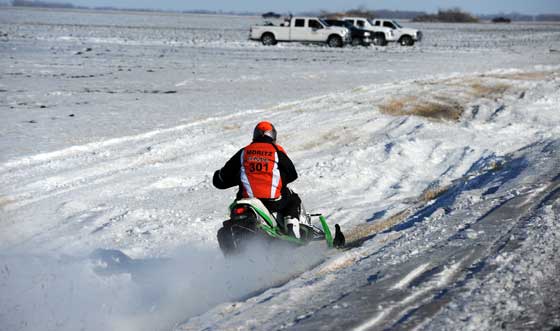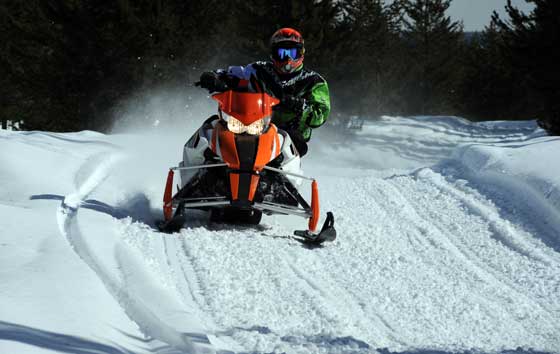
My last ride of the 2013 snowmobile season took place on the C.J. Ramstad Memorial North Shore State Trail which, due to a combination of no grooming (too warm/too late in the season) and some heavy snowfall in the preceding days, produced some pretty rough conditions. Not the normal stutter-bump-rough that happens when heavy traffic slams a trail during a normal winter weekend, but kind of a wind-drifted, uneven rough with varying-sized bumps, many of which had sharp edges. It was the kind of rough that kept us on our toes, and made me glad I was riding a Sno Pro suspension package.
A 2-in. coating of fresh snow the evening before we rode, which meant we were making first tracks on this quiet Monday in April.
For the first half of the day I rode second-to-last. This allowed me to watch the riders and tracks ahead of me, which provided an interesting study on line choice.
When corners approached or we were in sections with obstructed views of possible oncoming sleds, the riders in our group stayed center/right. But on long sections of trail where we could see any potential oncoming traffic, riders would essentially fan out across the trail, searching for the smoothest lines. As always, the smoothest line was invariably on the edges of the trail. And when I say edge, I mean the very edge.
When riding on the right edge of the trail, usually the right ski was rubbing on the edge created from the groomer. And often the ski tracked over the edge that groomer made.
Taking the smooth lines available at the margins is more challenging and requires constant experimentation, for sure, but it rewards with the smoothest surface. That translates into more comfort and less fatigue. It also allows you to ride with greater control at a given speed.
When I think back, I realize that racing provided my introduction to this kind of riding. The first guy I personally noticed who chose unique lines was Kirk Hibbert. Whether it was in hillclimbs, cross-country or snocross, Kirk always plied the margins to find the fastest route to the finish.
I’ve observed the same creativity, experimentation success with Brad Pake, Steve Houle, Jack Struthers and Blair Morgan (who was a master at exploring the margins), to name a few.
You can see the same mindset watching the best oval racers deftly weave through the dirt/holes that develop at Eagle River, maintaining both speed and the sharp edges of their traction products.
Pay attention to Tucker Hibbert and you’ll see him deliver a clinic in line-choice creativity.
The same is true if you’re able to watch Arctic Cat’s Engineering and Field Test riders, whose decades of riding experience have taught them the same lessons for staying fresh and observant during the 200-plus-mile rides that characterize their winter days.
Personally, I love riding this way, in part because of the challenge it offers, in part because of the reward (smoother conditions) and in part because it requires concentration.
I’m convinced that when I ride this way – concentrating on trail conditions and being VERY deliberate with line choice – I’m riding safer than when I turn down the concentration and stroll along with less deliberation.
I don’t always ride the margins, nor am I suggesting that everyone should. Sometimes conditions and circumstances don’t allow it. However, it can be one of the many options for enjoying a trail ride.

This photo of Kale carving a corner illustrates one of the best circumstances for riding the outside edge: by staying on the far right while going through left-hand turns. It amazes me how few people stay on the outside (and the right side) when negotiating a left turn.

I think it’s far more common for people to run the middle line or, worse, inside/left side line when taking a left turn.

This photo taken on the Ramstad/North Shore trail in the winter of 2012 illustrates just how wide the trail is in some spots. There are effectively four usuable lanes, with the vast majority of the traffic using lanes 2 and 3 (the center lanes). This is why running lanes 1 and 4 provides some relief from the bumps that form in the heavily-pounded center lanes.

Ditch riding provides a whole different level of margin exploration. Here Arctic Cat engineers Brian Dick (L) and Roger Skime pick the lines on the waaaaay inside of a ditchline.

Watching a cross-country race provides a strongly visual example of line choice. Here Team Arctic’s Nathan Moritz searches for the smooth (fast) line at a USCC race in Grafton, ND, in 2012.




Good stuff as always John! Really miss the Grafton, ND race. That was always a lot of fun. Keep up the good work!
This is like reading what my Dad would tell me as a young rider…. STAY ON THE RIGHT SIDE OF THE TRAIL…. smoothest line on the trail…. He would always say “Everyone rides right down the middle the trail.” So, I did and I still do ride on the farthest right side of the trail… Got a little burnt by it though this year… Caught a hidden rock that tossed me. Freak accident. I’ll still ride that line on that trail. I know that rock was hauled away! : ) Great write up John! Thank you!
Sure glad we don’t have to worry about trails in northwestern Minnesota………………………………………..